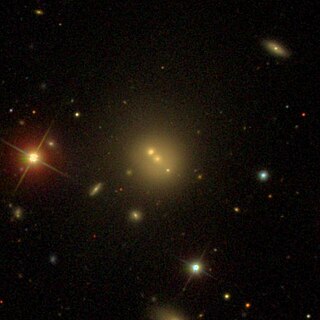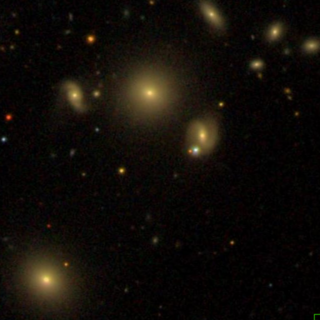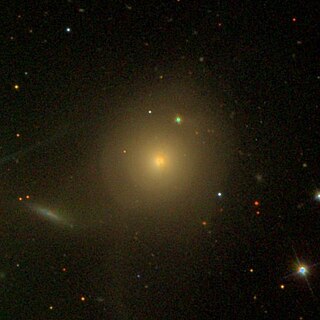
NGC 3550 is a lenticular galaxy in the constellation Ursa Major. It was discovered on April 11, 1785, by William Herschel. It is one of the brightest galaxies of the Abell 1185 galaxy cluster.

NGC 3552 is a lenticular galaxy in the constellation Ursa Major. It was discovered on April 11, 1785 by William Herschel. It is a member of the galaxy cluster Abell 1185.

NGC 3539 is a lenticular galaxy in the constellation Ursa Major. It was discovered in April 1831 by John Herschel. It is a member of the galaxy cluster Abell 1185.

NGC 467 is an unbarred lenticular galaxy in the constellation Pisces. It was discovered on 8 October 1785 by William Herschel.

NGC 178 is a Magellanic spiral galaxy in the constellation of Cetus. The compiler of the New General Catalogue, John Louis Emil Dreyer noted that NGC 178 was "faint, small, much extended 0°, brighter middle". It was discovered on November 3, 1885, by Ormond Stone.

NGC 3402, also known as NGC 3411, is an elliptical galaxy in the constellation Hydra. The object was discovered on March 25, 1786 by German-British astronomer William Herschel. NGC 3402 is the largest galaxy in the eponymous NGC 3402 cluster.

NGC 3319 is a barred spiral galaxy in the constellation Ursa Major. It was discovered by William Herschel on Feb 3, 1788. It is rich in gas and lacks a galactic bulge.

NGC 950 is a barred spiral galaxy in the constellation Cetus. It is approximately 205 million light-years away from the Solar System and has a diameter of about 85,000 light-years. The object was discovered in 1886 by American astronomer and mathematician Ormond Stone.

NGC 960 is a spiral galaxy in the constellation Cetus. The galaxy was discovered in 1886 by Francis Preserved Leavenworth.

NGC 670 is a lenticular galaxy located in the Triangulum constellation about 165 million light years from the Milky Way. It was discovered by the German-British astronomer William Herschel in 1786.

NGC 906 is a barred spiral galaxy in the constellation Andromeda in the northern sky. It is estimated to be 215 million light years from the Milky Way and has a diameter of approximately 110,000 ly. NGC 906 was discovered on October 30, 1878 by astronomer Édouard Stephan.

NGC 535 is a lenticular galaxy in the constellation Cetus. It is estimated to be 222 million light years from the Milky Way and has a diameter of approximately 65,000 light years. The supernova SN 1988ad was observed near these coordinates. NGC 535 was discovered on October 31, 1864, by astronomer Heinrich Ludwig d'Arrest.

NGC 706 is a spiral galaxy located in the Pisces constellation about 230 million light years from the Milky Way. It was discovered by the German–British astronomer William Herschel in 1786.

NGC 736 is an elliptical galaxy in the constellation Triangulum. It is an estimated 200 million light years from the Milky Way and has a diameter of approximately 85,000 light years. NGC 736 was discovered on September 12, 1784 by the German-British astronomer William Herschel.

NGC 766 is an elliptical galaxy located in the Pisces constellation about 362 million light years from the Milky Way. It was discovered by British astronomer John Herschel in 1828.

NGC 644 is a barred spiral galaxy in the constellation Phoenix in the southern sky. It is estimated to be 270 million light-years from the Milky Way and has a diameter of approximately 130,000 light-years. Together with NGC 641, it probably forms a gravitationally bound pair of galaxies. The object was discovered on September 5, 1834 by John Herschel.

NGC 645 is a barred spiral galaxy in the constellation Pisces. It is estimated to be 112 million light-years from the Milky Way and has a diameter of approximately 115,000 light years. The object was discovered on October 27, 1864 by astronomer Albert Marth.

NGC 532 is a spiral galaxy in the constellation Pisces. The galaxy is approximately 100 million light-years away from the Earth, and was discovered on September 21, 1786, by the German-British astronomer William Herschel.

NGC 623 is a large elliptical galaxy located in the Sculptor constellation at a distance of about 400 million light-years away from the Milky Way. It was discovered by British astronomer John Herschel in 1837.

NGC 861 is a spiral galaxy in the constellation Triangulum. It is estimated to be 360 million light-years from the Milky Way and has a diameter of approximately 165,000 light-years. The object was discovered on September 18, 1865 by Heinrich d'Arrest.




















